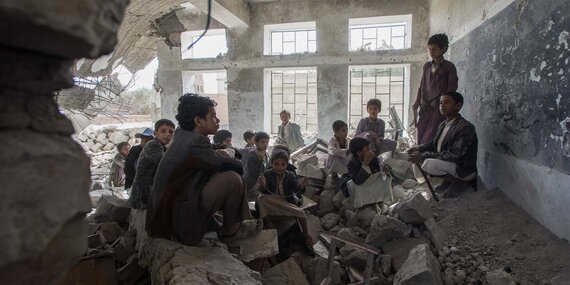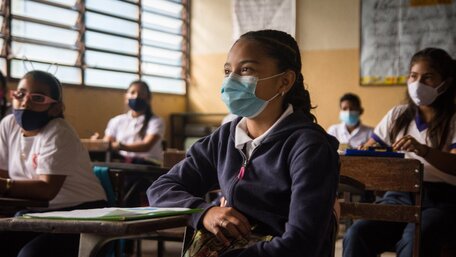Saada, Yemen
Students at the Aal Okab School sit in a former classroom, which was destroyed during the conflict. Students now attend lesson in UNICEF tents nearby. OCHA/Giles Clarke
Years of conflict continue to cause crippling humanitarian consequences in the Middle East and North Africa region. Vulnerable people’s ability to cope and meet their basic needs is hampered by the effects of COVID-19, macroeconomic decline and the climate crisis. Over 55 million people across the region need humanitarian assistance, including more than 12 million people who are internally displaced and facing a myriad of challenges.
Humanitarian Response Plans
Hostilities are devastating communities, increasing protection risks and concerns in oPt, Syria and Yemen, and exacerbating civilian suffering, deaths and injuries. Children and people in need are in extreme danger from daily indiscriminate attacks on schools and hospitals, preventing meaningful access to services. Many displaced people in Iraq, Libya, oPt, Syria and Yemen live in poor conditions in camps and settlements, with limited access to basic services and the potential risk of eviction.
The effects of conflict are compounded by recurring climatic shocks and extreme weather conditions, including floods and extended dry conditions. The frequency and magnitude of these shocks increases year on year. In Syria, erratic rainfall and tensions over water resource management have resulted in low water levels in the Euphrates River, affecting up to 5 million people. Floods in Yemen have displaced 34,000 families and spread preventable waterborne diseases, such as cholera. The socioeconomic impacts and containment measures associated with the pandemic have increased pre-existing vulnerabilities and stretched already weakened health-care systems. Vaccination rates remain low and vaccines difficult to access.
Middle East and North Africa: Overview of appeals
Across the region, many countries are battling economic collapse, including soaring food and fuel prices, currency depreciation, limited household revenue and rising unemployment. Families cannot afford basic goods and services including food, health care, education and water. Food insecurity and nutrition have continued to worsen, with millions of people in Lebanon, Syria and Yemen on the brink of hunger and resorting to negative coping mechanisms. Famine-like conditions are evident in parts of these countries.
Middle East and North Africa: Evolution of needs
Humanitarians continue to deliver assistance to affected people and minimize human suffering against a backdrop of challenges due to conflict, insecurity, the impact of sanctions on humanitarian response, blockades and bureaucratic impediments. Into 2022, the region is expected to face significant challenges. These will result in increasing humanitarian needs that require greater humanitarian effort in tandem with development assistance. Political solutions to the conflicts in oPt, Syria and Yemen are yet to materialize. As a result, millions of people cannot return to their homes or explore other durable solutions. Food insecurity persists and is expected to deteriorate, particularly in Yemen. Meanwhile, economic contraction is likely to worsen the standard of living for millions of people who will need additional humanitarian assistance.
Further reading
Source: OCHA
Iraq
Analysis of the context, crisis and needs
Four years after the conclusion of large-scale military operations against ISIL, millions of Iraqis have yet to recover from the years of extreme violence and widespread displacement. Recovery and reconstruction remain incomplete, social tensions are often high, and security is complex and fragmented. Iraq’s political future is uncertain and evolving, with parliamentary elections completed in October 2021. The country’s economy is gradually recovering from numerous shocks in 2020, however, many structural economic challenges continue. Climate change is a growing threat in Iraq. Displaced and returnee communities continue to be disproportionally vulnerable to and impacted by shocks in the context.
The situation affecting millions of Iraqis currently or formerly displaced by the 2014-2017 ISIL crisis remains broadly stagnant, as compared to 2021. Some 1.2 million people remain internally displaced, including 1 million outside formal camps. Returns continue to be slow, with the number of displaced Iraqis only decreasing by 35,000 so far this year. Many IDPs and returnees face significant barriers that prevent them from finding durable solutions. These barriers include missing civil documents, contamination from unexploded ordnance, and insufficient housing, basic services and livelihoods in their area of displacement or at home. Vulnerable internally displaced persons (IDPs) and returnees alike also are at increased risk for other serious protection risks.

Erbil, Iraq
Local workers at the ICRC warehouse load rice sacks into a truck that will head to Baghdad for a food distribution.
Finnish Red Cross/Saara MansikkamäkiThroughout 2021, the Government of Iraq, UN development agencies, the international humanitarian system, national and international NGOs and donor representatives have accelerated efforts to expand engagement and support to end displacement. The need for humanitarian assistance will continue until this goal is fully achieved, and through collaboration, advancements are foreseen over the next year.
Projected situation in 2022 and beyond
Using tightened criteria to define and assess humanitarian need, evidence shows that some 2.5 million Iraqis remain highly vulnerable and in need in 2022. This translates to about half of all IDPs (180,000 in-camp IDPs plus 550,000 out-of-camp IDPs) and one third of all returnees (1.7 million) being highly vulnerable and in need. The number of people in acute need decreased by nearly 60 per cent year-on-year, from 2.4 million to 960,000. These reductions are the direct result of the revised methodological approach rather than the result of an improved context. Many people previously assessed as being in need remain so, often for socioeconomic or other medium-term support, and should be assisted in 2022 through Government and development action.
Twenty-seven formal camps remain open in Iraq: 25 in the Kurdistan Region of Iraq and two in federal Iraq at the time of writing. Only 1 per cent of in-camp IDPs have noted an intention to return to areas of origin in 2022. Some additional camps may close or consolidate in the coming months, and some may see services transferred to the Government. However, all in-camp IDPs are expected to remain in need of humanitarian assistance in 2022.
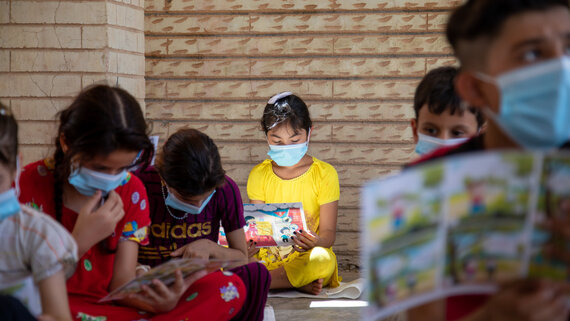
Baiji, Iraq
Children receive mine-awareness risk education sessions outside a school in Baiji, Salah al-Din.
Halo TrustAmong the 1 million IDPs living outside camps, 55 per cent are assessed as being highly vulnerable and in need of humanitarian assistance in 2022, using the tightened criteria. Their situation is often more precarious than IDPs living in the camps due to greater challenges accessing services or livelihoods in their host communities, risks of eviction, and exposure to protection risks, including higher reliance on negative coping mechanisms. IDPs living in critical shelter, including several hundred informal sites throughout Iraq, and those who lack core civil documentation are also of particular concern and focus.
Many of the 1.7 million returnees who remain in humanitarian need to do so because of the conditions in the areas of return, where many continue to live in critical shelter, without access to essential services or livelihoods and where the resumption of safe and dignified living is not yet feasible.
Response priorities in 2022
The 2021 Iraq Humanitarian Response Plan (HRP) targeted 1.5 million people, with 1.2 million people projected to be reached with assistance by year’s end. Response gaps are largely attributable to lack of funding and partner capacity. The approach and criteria used for targeting people for humanitarian interventions in 2022 have been revised through a tighter definition of needs and a more realistic prediction of humanitarian implementation capacity, funding, access and reach. Initial analysis shows that the 2022 Iraq HRP will likely target around 990,000 Iraqis with humanitarian assistance. This would include all in-camp IDPs, 230,000 acutely vulnerable out-of-camp IDPs and 580,000 acutely vulnerable returnees who face a multitude of humanitarian needs.
Iraq HRP
The strategic objectives of the 2022 Iraq HRP continue to focus on supporting IDPs and returnees to live in safety and dignity, access essential services and meet their basic needs. Within this framework, specific objectives will capture the different levels of support needed for in-camp IDPs, out-of-camp IDPs and returnees.
In addition to providing life-saving and life-sustaining humanitarian support, the humanitarian community in Iraq will continue to work closely with development and stabilization entities to operationalize the nexus, including through the area based coordination groups, and to contribute to the adoption of a shared understanding of and coordinated action in response to the priority drivers of need.
Further reading
Source: Humanitarian Insight
Source: Financial Tracking Service
Source: Office for the Coordination of Humanitarian Affairs
Lebanon
Analysis of the context, crisis and needs
Lebanon is facing the impacts of economic and financial collapse, COVID-19, the Beirut Port explosions and the Syrian crisis. In addition, political deadlock fuels popular protests and hampers meaningful reform and recovery efforts. In this context, the situation of ordinary people in Lebanon is worsening day by day. Secondary data analysis indicates increasing humanitarian needs within Lebanese and migrant communities. In addition, the preliminary findings of the 2021 Vulnerability Assessment of Syrian Refugees in Lebanon reveal a dire situation. Half of 879,598 Syrians registered as refugees with UNHCR are considered food insecure and about two thirds have to reduce the number of meals consumed per day.
Since October 2019, the Lebanese pound has lost more than 90 per cent of its value, leading to a year-on-year inflation of 120 per cent between May 2020 and May 2021. Assessments indicate that unemployment among migrants was up to 50 per cent, with significant job losses in the final quarter of 2020. The sharp devaluation in the Lebanese pound has eroded living standards and wiped-out life savings, as residents grapple with triple-digit inflation rates for 15 consecutive months. Food and non-alcoholic beverages, which account for the bulk of poor households’ expenditures, witnessed a staggering 253 per cent annual average inflation rate in 2020.
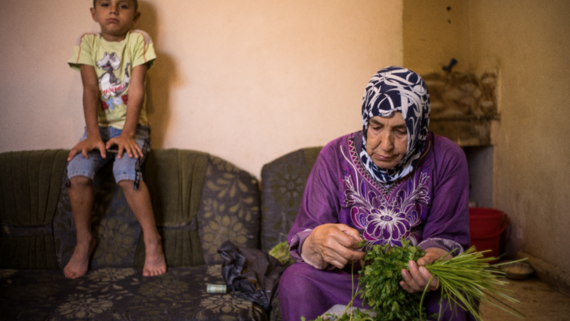
Tripoli, Lebanon
A woman prepares tabbouleh – Lebanon’s national dish of parsley, burghul, tomatoes and oil. These ingredients are among the many items facing a sharp price increase. Her daughter says: “Before COVID-19 and all that is happening, everything in Lebanon was somehow affordable.” She recalls that in early 2019, a supermarket visit did not mean spending the minimum wage (equivalent to $34) on just a couple of staple items.
WFP/Giulio OrigliaAmid growing scarcity, an increasing number of families cannot afford increasingly limited basic goods and services including food, health, education, electricity, water and hygiene items. The minimum wage in Lebanon is equivalent to a mere US$35/month, while the population is bearing the brunt of the removal of subsidies on crucial imports. The price of 20 litres of gasoline and a tank of cooking gas now represents respectively almost half and more than a third of the monthly minimum wage. This has pushed the population into poverty, with an estimated 35% now below the extreme poverty line.
Electricity outages due to the fuel shortage are jeopardizing the availability of health care and drinking water for almost everyone in Lebanon. Many hospitals have been forced to reduce their operations to the bare minimum. The public water and wastewater treatment systems, which rely heavily on fuel, have also been drastically cut across the country, leaving millions of people without access to water in the middle of the COVID-19 pandemic.
The situation has considerably increased the number of violent inter and intra community incidents linked to competition over goods and services. In addition, an increase in irregular migration is already reported with frequent incidents observed in 2020 and 2021.
Projected situation in 2022 and beyond
The current downward spiral of socioeconomic conditions cannot be assessed in isolation of the evolving political developments and existing sectarian divides within the Lebanese society. Delays in forming the Government have put the country’s priorities in jeopardy, from IMF negotiations to electricity sector reform, to elections being held on time. Until the elections, due in March 2022, a multiple exchange rate system and continued deterioration of the socioeconomic situation is likely to result in further impoverishment and acute supply shocks across basic services.
Unfortunately, to date, Government-led emergency measures required to alleviate the suffering of millions of residents are yet to be put in place. The economic outlook is bleak for 2022, as IMF technical talks are at their infancy and formal negotiations on a multi-year IMF support programme are expected to take several more months in a best-case scenario. The pre-electoral period is also likely to fuel continued popular unrest and further increase the politicization of the reform and aid agenda.
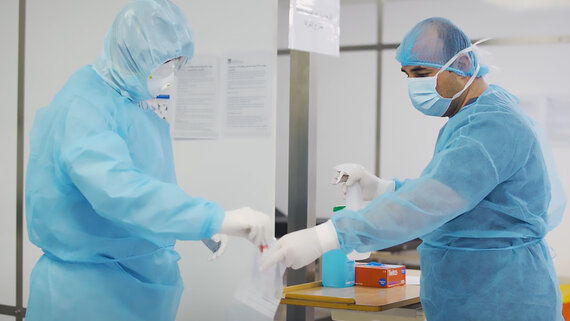
Beirut, Lebanon
Staff at COVID-19 Intensive Care Unit of the Rafik Hariri University Hospital wear personal protective equipment donated by WHO. The current crisis in Lebanon, coupled with the COVID-19 pandemic, has disrupted the health system. Patients face numerous cost barriers when trying to access healthcare services, including the PCR tests required for in-patient procedures. The Emergency Response Plan for Lebanon aims to support the capacity of the Lebanese health system to respond to and cope with the COVID-19 emergency.
WHOIn 2022, increased competition over employment and intracommunal tensions within Lebanese communities are likely to worsen in a context of persistent shortages of basic essential goods and services. Tensions between host communities and refugees are also likely to increase. Overall, it is anticipated that in 2022 the increasing tensions and sporadic violence will further reduce the operational space for humanitarian actors, who already face an increasing number of access challenges. Such trends will ultimately further increase the number of people in need of acute humanitarian assistance.
Response priorities in 2022
The Emergency Response Plan (ERP) is envisaged as a time-bound exceptional response to the current situation, pending the implementation of Government-led sustainable solutions to the crisis, including a full-fledged comprehensive and inclusive Government-led social protection strategy. The plan aims at linking with and preparing the transition towards such solutions to address the root causes of the crisis. The ERP is strictly humanitarian in nature and activities are implemented in full compliance with the HCT-endorsed Joint Operating Principles. It complements other humanitarian activities implemented in UNRWA programs and the UNHCR/UNDP-led Lebanon Crisis Response Plan. As such the ERP PIN and number of beneficiaries targeted have been calculated by taking those other plans into consideration.
The strategic objectives of the ERP are threefold, namely to:
-
Provide essential short-term support to most vulnerable people affected by the economic crisis for them to meet their critical needs in terms of health care, food, nutrition, education and water.
-
Support the response capacity of the Lebanese health system in coping with the COVID-19 emergency.
-
Enhance timely, unhindered and equitable access to protection assistance for migrants.
The intervention sectors included in the ERP are health, food security, nutrition, WASH, education, child protection and gender-based violence, logistics and a chapter focusing on migrants’ specific protection needs. The activities mostly comprise direct support to beneficiaries, this includes distribution of food and cash assistance for basic needs, including access to basic services including, health, water electricity.
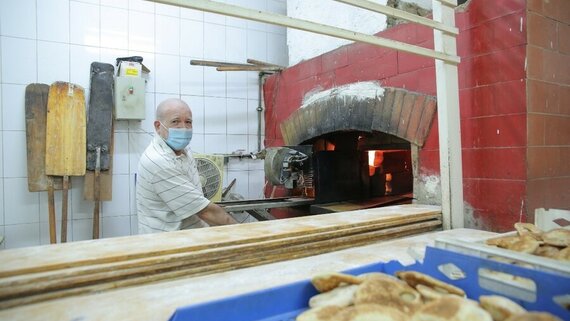
Beirut, Lebanon
This man is a shop owner who received assistance from WFP after the deadly blast that rocked Beirut a year ago, plunging millions of people across Lebanon into poverty. His bakery was wrecked in the blast and he finds it hard to be optimistic about the future. “We are waiting for a miracle to happen”. The economic crisis in Lebanon has taken a toll on everyone. People are losing their homes and sources of income, leaving many unable to buy enough food for themselves, let alone their families. Slowly, he was able to repair the shop and get back on his feet to some degree. Operating at only 25 percent efficiency compared to before the explosion, he continues to open the door to his bakery in the hope of one day fully returning to the way things were. The shop is more than a source of income, it is a part of who he is. “There is no reason for us to open, yet we are open. We chose to stay with whatever we have. This is my business. My soul is in it. I was born for this work."
WFP/PhotolibraryIn line with the Inter-Agency Standing Committee’s commitments on accountability to affected populations (AAP) and protection from sexual exploitation and abuse, the Humanitarian Country Team is collectively accountable to people with humanitarian needs in Lebanon. The humanitarian community will look to enhance a collective AAP approach in implementing the ERP, building on available mechanisms and tools and ensuring synergies with current platforms. Collective AAP mechanisms will support both a people-centred and a community-centred approach to a) ensure equitable and meaningful access to available information and services, b) leverage the participation of affected people, including marginalized groups and hard-to-reach communities, and c) promote two-way communication between humanitarian partners and the affected communities, using their preferred languages and assistance modalities.
The ERP aims to ensure that the specific and diverse needs, capacities and priorities of women, girls, men, boys and gender non-conforming individuals are identified and responded to. Integrating gender equality in the ERP also reinforces a human rights-based approach, which improves programming. Attention to gender equality will be prioritized in all aspects of the ERP, including needs assessments, strategic planning, coordination, implementation, and monitoring and evaluation. Sex-, age-, and disability-disaggregated data will be collected and analysed, to the extent possible, across sectors and used to improve access and impact to diverse marginalized groups. Humanitarian coordination, technical assistance, information management and advocacy efforts related to gender equality will be supported by Lebanon’s Gender Working Group and the LGBTIQ+ Task Force (sub-working group), which oversees gender-related coordination across the humanitarian-development and peace interventions.
Multipurpose cash assistance (MPCA) is critical in assisting households affected by multiple vulnerabilities requiring a holistic response. Assistance will be distributed based on clear targeting and eligibility criteria by NGOs and UN agencies working collaboratively across sectors, drawing upon lessons from the recent response following the August 2020 Beirut Port explosions, where cash assistance, particularly MPCA, enabled a timely response to urgent needs. Under the framework of the 2021-2022 ERP, partners will provide about US$140 million in direct cash assistance, which is approximately a third of the ERP’s overall funding requirement. Of this amount, $27.25 million (20 per cent) is planned to be distributed in the form of MPCA, complementing other assistance including sector-specific cash and voucher assistance.
Further reading
Source: Humanitarian Insight
Source: Financial Tracking Service
Source: Office for the Coordination of Humanitarian Affairs
Libya
Analysis of the context, crisis and needs
Since the ceasefire agreement was signed in October 2020, the overall humanitarian situation has seen some improvement across Libya, highlighted by the continuing trend in the number of internally displaced persons (IDPs) returning to their areas of origin. The number of IDPs decreased nearly 25 per cent to 213,000 people compared to some 278,000 at the start of 2021. This is an encouraging trend, but challenges remain in ensuring that returnees and vulnerable populations have access to essential services, such as health care, safe drinking water and suitable housing. Planned and often forcible evictions targeting IDPs is of critical concern, leading to a heightened risk of secondary displacement and insecurity over housing, land and property rights. Returns continue but the trend is slowing as those still displaced face systemic impediments, including personal security and social cohesion, and require durable solutions.
According to IOM’s Displacement Tracking Matrix, nearly 598,000 migrants are in Libya. The trend of migrants and refugees attempting the dangerous journey to cross the Mediterranean to seek economic opportunities has continued. By the end of September 2021, the Libyan Coast Guard had intercepted and returned almost 26,000 migrants and refugees to Libya. At the same time, the number of migrants and refugees held in detention centres run by the authorities has increased significantly since the beginning of the year and more so in recent months, as authorities mount security operations to round up migrant populations in Tripoli. As of 17 October, over 7,000 migrants and refugees were held in dire conditions in detention centres, without access to due process, compared to some 1,000 detainees in January.
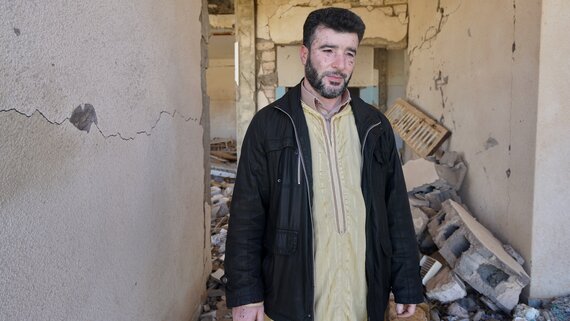
Awenia, Libya
This doctor was appointed as the Director of the Mashasheya hospital in Awenia. Before 2011, over 100 staff served a community that numbered around 15,000 people. This mountainous region saw some of the heaviest fighting during the 2011 revolution. Villages of suspected pro-Gaddafi supporters were attacked and destroyed and still lie in ruins. People now returning live in difficult conditions, as many houses have no electricity or running water and winters are often harsh. The Mashasheya hospital suffered major damage and remained closed until October 2018. The doctor, who had recently returned from Tripoli, offered to re-open part of the damaged facility. Despite the fact there was no electricity or running water, he treated patients with basic injuries.
OCHA/Giles ClarkeLibya continues to struggle with the challenges of the COVID-19 pandemic, straining the already fragile health system. Libya only began its vaccination campaign in April 2021. Vaccination remains slow (5.7 per cent fully vaccinated) and the pandemic will continue to pose risk for the population and operational challenges for the response. With no national budget approved for 2021, the lack of funding hampered programming and impacted health facilities’ ability to remain fully operational.
Vulnerable families are negatively impacted by the rise of the Minimum Expenditure Basket, which increased by 2 per cent by July. Between June and July, a 2.2 per cent raise was noted in the price of the food components. The price of some components decreased, but it remains 13 per cent higher than pre-COVID-19 levels, which, combined with the loss of income and lack of work opportunities, has increased coping mechanisms.
Primary infrastructure requires urgent rehabilitation. Armed groups and criminals increased their attacks on water and sanitation infrastructures, which led to the stoppage of regular water supply in some areas, coupled with deteriorating desalination plants and electricity cuts. This affected approximately 1.6 million people.
Projected situation in 2022 and beyond
An estimated 800,000 people need some form of humanitarian assistance next year, a 36 per cent decrease compared to 2021. Based on the multisectoral severity scale, the highest needs are found in Bani Waleed and Rigdaleen Baladiya in the west region; Ghat and Ubari in the south; and Albayda, Tazirbu, Derna and Jalu in the east. The most vulnerable groups are IDPs, migrants and refugees.
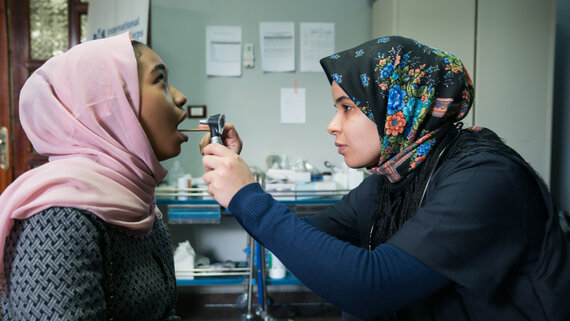
Tripoli, Libya
A doctor performs a medical examination at a migrant health clinic in Tripoli. Lack of funding hampered programming and affected health facilities’ ability to remain fully operational.
OCHA/Giles ClarkeIf the political reconciliation continues, some of the most pressing humanitarian concerns should decrease, especially for non-displaced and returnee populations. Access to services would likely improve as increased revenue, specifically from the oil sector, would allow more investment in public services delivery. If conflict returns, an estimated 1.6 million people could be affected. Preparedness efforts are in place for a rapid response in case needed. The main challenges are the limited presence of operational partners on the ground and safe storage facilities that could allow the pre-positioning of supplies.
Response priorities in 2022
IDPs, returnees, migrants, refugees and non-displaced people are currently affected in Libya and will remain the priority vulnerable groups from January to May 2022. The Humanitarian Response Plan (HRP) will target some 211,000 of the most vulnerable people in the first five months of 2022. Challenges remain for displaced persons with critical protection risks increased by forced evictions and conditions of returns not meeting basic standards; and exposing IDPs, returnees, migrants and refugees to family separation, arbitrary arrest, as well as intimidation by unregulated armed groups.
Libya HRP
The need for a durable solutions approach encompassing physical, material and legal safety remains a priority for the identified groups, many of whom struggle with accessing services or sustainable livelihoods.
The HRP funding requirement from January to May 2022 will be US$75.3 million. The HRP will complement the Libyan Government and private sector efforts to assist the most vulnerable people in need from January to May, while developments on the ground will determine the scale and scope of any future appeal.
Further reading
Source: OCHA
Source: Humanitarian Insight
Source: Financial Tracking Service
occupied Palestinian territory
Analysis of the context, crisis and needs
The occupied Palestinian territory (oPt) remains a protracted protection crisis, where too many men, women, boys and girls struggle to live in dignity, with constrained access to basic services. The crisis is characterized by 54 years of military occupation, insufficient respect for international humanitarian and human rights law, internal Palestinian political divisions, and recurrent escalations of hostilities between Israeli forces and Palestinian armed groups.
In Gaza, the humanitarian situation deteriorated in 2021, with the most intense escalation of hostilities since 2014. Beyond the human toll, the 11-day conflict in May aggravated chronic shelter and infrastructure needs. According to the oPt 2021 Multisectoral Needs Analysis (MSNA), the conflict affected the livelihoods or assets of half of the households in Gaza, including some 8,250 people who remain displaced as a result of the escalation. At the same time, the humanitarian needs in all sectors persist, with the blockade on Gaza by Israeli authorities who cite security concerns, entering its fifteenth year.
In the West Bank, including East Jerusalem, 2021 witnessed a spike in Palestinian casualties by Israeli forces, raising concerns about excessive use of force. Attacks on Palestinians and their property by those known or believed to be Israeli settlers has increased. Threats of forced evictions in East Jerusalem and demolitions or seizures of structures and property by the Israeli authorities in Area C and East Jerusalem has also increased, with several significant mass demolitions recorded. Many of these and other Israeli practices in the West Bank including East Jerusalem are linked to the presence of Israeli settlements, which intensifies the coercive environment on vulnerable communities, accentuating the risk of forcible transfer.

Gaza, occupied Palestinian territory
A young boy picks up a schoolbook from the rubble following the Israeli air strikes in May 2021. Every time there is a conflict in Gaza, intense air bombardments destroy basic infrastructure, homes, hospitals and factories. It takes aid agencies several years to rehabilitate their premises, and many homes and livelihoods are never rebuilt.
UNRWA/Mohamed HinnawiThe impact of the COVID-19 pandemic has also intensified, with a third wave underway in Gaza and a fourth in the West Bank, burdening the already-stretched health-care system and increasing poverty levels. The pandemic is also intensifying needs and vulnerabilities, with 62 per cent of households in the oPt reporting that their monthly income had decreased as a result of COVID-19.
The Fatah-Hamas divide remains unresolved, undermining basic services in Gaza. Humanitarian response in Gaza was at times restricted by Hamas. In the West Bank, the killing of a prominent Palestinian critic of the Government in June and the subsequent use of force against those protesting the incident has raised concerns of heightened human rights abuses by the Palestinian Authority.
The Israeli authorities maintained physical, administrative and laws or military orders which can in effect limit humanitarian programming. Despite current financial constraints, UNRWA has continued providing basic services at scale for Palestinian refugees both in Gaza and the West Bank including East Jerusalem from its own Programme Budget which is supported by voluntary contributions.
Projected situation in 2022 and beyond
Notwithstanding the ceasefire in May, there were no political advances or major improvements on the ground in 2021. The drivers of the humanitarian crisis in Gaza remain. In the absence of a political process, improvements are not expected in 2022, increasing the risk of additional escalations.
In the West Bank, including East Jerusalem, levels of Palestinian casualties, settler violence and demolitions have increased. In East Jerusalem, nearly 1,000 Palestinians also face the threat of forced eviction by the Israeli authorities, largely due to court cases initiated by settler organisations. Together with the financial uncertainty of both UNRWA and the Palestinian Authority, these factors could lead to further destabilization, potentially expanding to Gaza, as was the case in 2021.
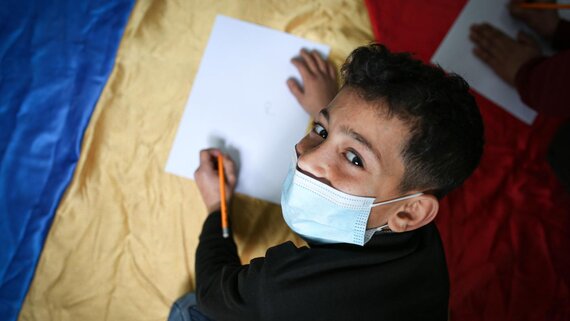
Gaza Strip, occupied Palestinian territory
A boy looks at the camera in one of the 12 family centres located throughout the Gaza Strip. Since 2009, humanitarian organizations have offered integrated psychosocial support and child-protection services to the boys and girls most affected by mental and psychosocial distress in the Gaza Strip, including children impacted by COVID-19. The protection services and life-skills education include safe and interactive activities that are culturally and age-appropriate to help children and their families recover from stress and return to everyday life.
UNICEF/Anas El BabaThe key drivers of the humanitarian crisis combined with COVID-19, have deepened the vulnerability of Palestinians and in turn have increased the demand for humanitarian assistance across the oPt, a trend likely to continue in 2022. Overall, 2.1 million Palestinians, 1.3 million in Gaza and 750,000 in West Bank, will need assistance in 2022. Some 63 per cent of all Gaza residents, and 23 per cent of those in the West Bank require humanitarian assistance. Needs related to living standards contribute to 64 per cent of the PIN, followed by those related to physical and psychological well-being (19 per cent) and coping mechanisms (17 per cent). A deterioration in livelihoods conditions is spurring an increase in cash and voucher assistance.
Throughout the oPt, the most vulnerable people are those living below the poverty line (1.4 million - World Bank 2020. Estimate for 2021 following May escalation project poverty increase in Gaza from 57.2 to 59.4 per cent): refugees, female-headed households, small-scale farmers, people with disabilities and those who were displaced as a result of their homes being entirely demolished or damaged due to the May 2021 escalation.
Response priorities in 2022
In 2021, humanitarian partners aimed to reach 1.8 million Palestinians with assistance through the Humanitarian Response Plan (HRP). As of August, partners had reached 1.15 million people, i.e. 64 per cent of people targeted are estimated to have received humanitarian assistance.
Key achievements included: legal aid services enabled nearly 80 per cent of targeted households facing demolition and eviction orders to delay the implementation of the order; more than 30,000 IDPs received emergency shelter support during and after the escalation of hostilities; 277,988 students (138,230 girls) benefited from emergency educational supplies; some 27,000 patients received front-line emergency and trauma hospital care, exceeding the target of 23,000 patients; 98 per cent of those targeted for food and cash assistance were reached and access to WASH services improved for more than 300,000 people.
oPt HRP
The 2022 plan is based on the assumption that the delivery of UNRWA services and assistance under its Programme Budget will continue across the oPt. Any reduction in this assistance would significantly impact all assumptions of humanitarian needs in Gaza and West Bank, including East Jerusalem upon which the HRP is based.
In 2022, an estimated 2.1 million Palestinians across the oPt will require humanitarian assistance; 64 per cent of whom live in Gaza. The refined targeting methodology used for 2022 has slightly reduced the PiN compared to 2021, but the severity of vulnerabilities to be addressed have significantly increased due to the deterioration of the socio-economic situation on the ground impacted by COVID-19 and further exacerbated by the escalation of hostilities and unrest across the oPt in May 2021.
Of the total number of people in need, humanitarian partners will aim to assist the most vulnerable (1.6 million people), with a financial requirement of US$510 million. People’s needs will be addressed through multisector efforts - to protect the rights of Palestinians living under occupation, provide access to essential services for the most vulnerable, and support their ability to cope with the effects of the crisis while more sustainable solutions are sought through a nexus approach and the development of the first Sustainable Development Cooperative Framework. The 2022 HRP will maintain the centrality of protection in delivering humanitarian response.
Further reading
Source: Office for the Coordination of Humanitarian Affairs
Source: Humanitarian Insight
Source: Financial Tracking Service
Syrian Arab Republic
Analysis of the context, crisis and needs
A decade into the crisis, factors driving humanitarian needs among Syria’s population have multiplied. The March 2020 Idleb ceasefire agreement led to a reduction in hostilities and large-scale displacement compared to the peak of the crisis. However, during the second half of 2021 hostilities have re-intensified along front lines in northern and southern Syria, triggering new displacements and destruction as well as continued violations of IHL and IHRL. At the same time, the long-standing needs of an estimated 6.9 million IDPs remain staggering, particularly for the over two million people in 1,760 informal settlements and planned camps, often hosted in inadequate shelters and limited access to basic services. Further, the needs of overstretched host communities and those who have returned to their – often destroyed – places of origin continue to face inadequate living standards.
Throughout 2021, the macroeconomic context has continued to deteriorate sharply. The combined effects of currency depreciation, soaring prices, reduced fiscal spending, widespread job loss and unilateral coercive measures have plunged additional segments of the population into humanitarian need, notably in areas historically less affected by hostilities and displacement. People’s ability to meet basic needs and access basic services has decreased further. Assessment data from August 2021, for example, indicates that the income gap has intensified across the country, with average household expenditure now exceeding available income by 50 per cent compared to 20 per cent in August 2020. As a result, families have taken on more debt and they increasingly resort to harmful coping mechanisms. These include child labour, child marriage and the sale of productive household assets. Food insecurity has grown; Syria ranked among the 10 most food insecure countries globally by mid-2021, with an estimated 12.8 million people considered food insecure.
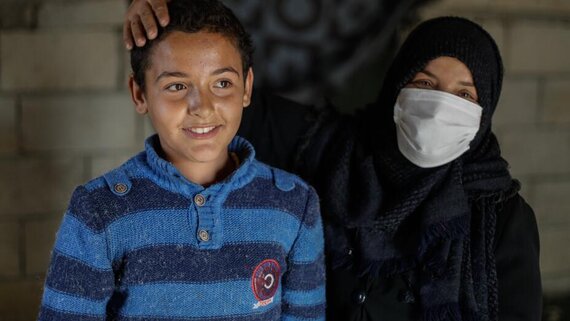
Northwest Syria
This boy and his family have been displaced three times due to constant shelling. Each time they moved his parents had to register him at a new school. His mother said: “He used to be an excellent student back in our village, but now he’s behind. He should be in sixth grade, but he has had to change schools so many times.” Despite the challenge of living through a decade of war, he remains optimistic: “My friends and I study together for our exams. My biggest hope in life is to become a doctor — or a soccer player.”
IRC/Abdullah HammamBasic service delivery across Syria continues to be vastly inadequate and hampered by damaged infrastructure, lack of critical supplies and, increasingly, financial unaffordability. One of the most pressing concerns is the scarcity of technical staff required to deliver and maintain basic services, due to displacement, death and/or impairment, and the lack of technical training. By way of example, in almost half of all sub-districts in Syria, the number of health-care workers (doctors, nurses and midwives) is less than 11 per 10,000 people. This is catastrophically below emergency standards of at least 22 per 10,000 people. With just 2 per cent of the population fully vaccinated against COVID-19 and the country recording its highest weekly case numbers as of late October, the pandemic continues to overburden the fragile health system.
In 2021, climatic shocks affecting natural resources, particularly water, have intensified and exacerbated humanitarian impact. In north and north-east Syria in particular, insufficient rainfall combined with historically low water levels in the Euphrates River have not only reduced access to water for drinking and domestic use for over 5 million people, but also triggered substantial harvest and income losses, an increase in waterborne diseases and additional protection risks. In the medium to long term, these developments are expected to worsen high food insecurity and malnutrition rates in the region.
Humanitarian access in Syria continues to be challenged by geopolitical dynamics, periodic border-crossing closures and COVID-19 measures. The number of border-crossing points authorized by the UN Security Council for UN-delivered assistance and supplies remains limited to one (Bab al Hawa at the Turkish border), which is a reduction from four in 2019.
Projected situation in 2022 and beyond
Downward trends are expected across all major need drivers in 2022. New or recurrent displacements across the country are likely to remain similar to those recorded in 2021 – an estimated 800,000 IDPs and 250,000 IDP return movements are expected in 2022. However, needs for humanitarian assistance to populations residing along or moving away from front lines are expected to increase. In a context where 90 per cent of the population is estimated to live below the poverty line, the socioeconomic deterioration is expected to trigger further increases in extreme poverty, and to aggravate already alarming food insecurity and malnutrition rates and protection concerns.
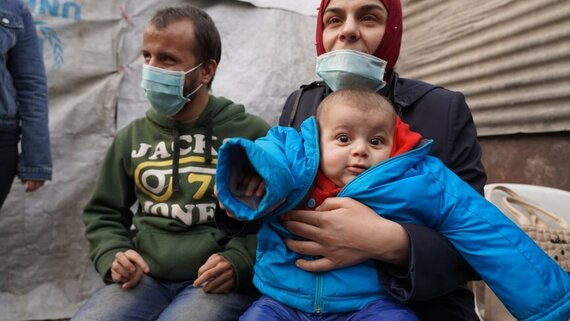
Aleppo, Syria
A visually impaired couple and their son wait at a food distribution point in Aleppo. He was born blind, while she has 1 per cent vision (their son is not visually impaired). The couple have lived in Aleppo throughout the conflict and receive WFP support for their basic needs. She says: “I love nature and sounds of birds. I can distinguish colours to a very small extent, so I love greenery and spacious areas, where you can smell grass. When mortars were falling, the sounds were terrifying. Those seconds of silence afterwards were the deadliest feeling I have ever experienced. Then we would start hearing screams of passers-by who might have been injured. Now, while walking together, we smell dust a lot. We feel rocks under our feet, so we know there is a destroyed building nearby. We feel shattered glass on the ground when we step on it, and it breaks our hearts.”
WFP/Jessica LawsonBasic service delivery will remain inadequate, albeit with significant geographic variations, and hampered by the lack of infrastructure, investment, human resources and, increasingly an unreliable electricity supply. If political agreements sustaining the functionality of critical water stations serving these areas are not found, regular access to safe water through public networks will remain a particular challenge for over 500,000 people in north-eastern Al-Hasakeh Governorate, as well as for an estimated 184,000 people in Al-Bab subdistrict in Aleppo Governorate. With COVID-19 vaccination coverage expected to grow slowly throughout 2022 and continued poor adherence to preventive measures, the population – particularly health-care professionals and front-line workers – will remain at heightened risk of contracting COVID-19, and health services will continue to be disrupted.
Response priorities in 2022
The humanitarian response in Syria – reaching 6.7 million people on average each month in 2021 – is estimated to have prevented a more pronounced deterioration in humanitarian indicators and served as a vital lifeline for millions of people. However, the response currently remains insufficient to stem or revert the downward trends described here. This is partly due to historic underfunding of the 2021 HRP – funded at only 44 per cent of total requirements as of 20th November 2021 – which is expected to have contributed to a slight decrease in the number of people reached each month (6.7 million in the first half of 2021 compared to 7.4 million in the same period in 2020).
Syria HRP
At the same time, needs related to basic service delivery, livelihoods and income generation have grown consistently across all population groups, as has the need for durable solutions for IDPs and returnees specifically. These needs require a more comprehensive, longer-term response, including through non-humanitarian instruments.
Adjusting to this reality, humanitarian planning for Syria will shift towards a two-year HRP, covering 2022 and 2023. While the three HRP Strategic Objectives (SOs) will remain the same (save lives, protect people, and improve access to livelihoods and basic services), a two-year humanitarian planning horizon for Syria is expected to enable a more strategic expansion of resilience and early recovery-oriented programming under SO 3 in particular, and strengthen advocacy for multi-year funding/commitments. In 2022, out of an estimated 14 million people in Syria who require humanitarian assistance, the UN and humanitarian partners aim to assist an estimated 12 million people, at an approximate cost of US$4.2 billion.
Further reading
Source: Office for the Coordination of Humanitarian Affairs
Source: Humanitarian Insight
Source: Financial Tracking Service
Yemen
Analysis of the context and crisis, needs and response
The crisis in Yemen remains extremely severe, with over 20.7 million people in need of humanitarian assistance. The crisis is fuelled by conflict and is further exacerbated by the economy’s decline, natural hazards such as floods or drought, and epidemics, notably COVID-19. Though Yemen had pre-existing vulnerabilities, the conflict’s increasingly protracted nature has resulted in economic collapse, increased poverty and the breakdown of national social-protection systems and community safety nets. It has exacerbated long-standing vulnerabilities and severely frayed Yemen’s social fabric. Loss of revenues, depreciation of the Yemeni rial and import restrictions resulted in loss of income and rising prices for most basic household items, including food. Millions of people are now in a situation where they can no longer meet their basic needs, with potential serious detrimental impacts on groups in society with limited social capital and protection mechanisms. This increases risks of adopting harmful coping strategies, such as debt, selling of assets, early/forced marriages, school dropout and child labour, with grave long-term impacts especially on women, children, older persons, persons with disabilities and marginalized communities.
In 2021, the conflict escalated in several areas along fluid lines of control, with continued breaches of international humanitarian law and consequent impact on the protection of civilians. As of October, 48 districts across Yemen are crossed by active front lines, an increase from 45 in 2020 and 35 at the end of 2019. Escalated hostilities and shifting front lines continue to challenge sustained humanitarian programming and resulted in aggravated humanitarian needs and increasing levels of new displacement. As of the end of September 2021, there were an estimated 1,498 civilian casualties in Yemen, including 401 children and 228 women, and at least 16 attacks affecting schools and hospitals. Large-scale destruction of civilian homes and infrastructure has created shelter needs, including for internally displaced persons (IDPs) who may consider returning to their place of origin.
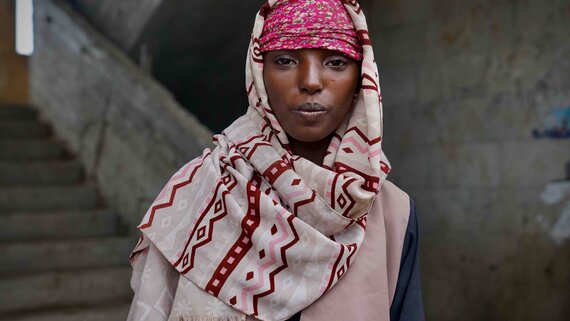
Dar Saad, Yemen
A 13-year-old girl in the Amin Bin Yassar informal settlement in Dar Saad. She said: “I live with my father and my seven brothers and sisters. My mother passed away a year ago. That was the most difficult thing for us. Since then, our life has changed. The eight of us live in a tent. We do not feel safe in the tent because it is exposed, and anyone can steal from us. What makes us happy is having food. I love cooking and science. I do not study but I like to learn. I cannot study now because I am the one who plays the role of my mother in the house. I want to be a doctor when I grow up.”
OCHA/Giles ClarkeThe conflict has displaced around 4 million civilians, including at least 158,000 in 2021. Some of the highest levels of vulnerability are concentrated among the estimated 1.3 million IDPs living in some 2,000 IDP sites, after being subjected to multiple displacements. In most sites few services are available, leading to precarious living conditions and continuous threats of eviction. An estimated 141,000 asylum seekers and refugees are at extreme risk, with shrinking asylum and protection space, and they remain highly reliant on humanitarian aid.
In addition, flooding devastated southern communities and fuelled the spread of diseases such as cholera, dengue, malaria and diphtheria. More than 34,000 families, most of them IDPs who fled conflict areas, lost their shelters, incomes and livelihoods. Floods are becoming annual events that will require contingency planning and response. Current projections show that locusts pose an unprecedented threat to agriculture-based livelihoods and food security.
The operating environment in Yemen has remained extremely challenging in the first nine months of 2021. During this period, 870 cases involving bureaucratic impediments were reported. Despite such impediments, there has been significant progress in authorities’ approval of projects and assessments, which enhances the timely delivery of principled humanitarian aid.
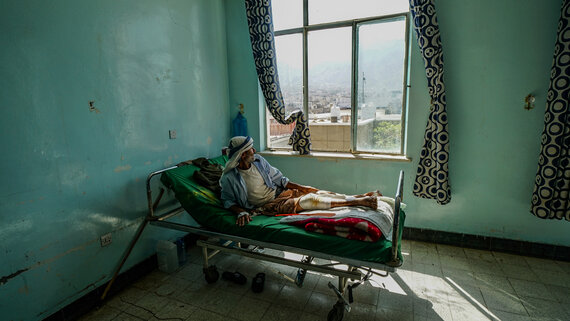
Taiz City, Yemen
An injured man in Al Thawra hospital, Taiz City. Rebel fighters have targeted the hospital many times since 2016; it is located just 1 km from the front line that ran through the city.
OCHA/Giles ClarkeDespite continued efforts to mitigate the risk of famine, food insecurity continues to remain a key challenge. It is most severe in areas of active conflict and surrounding areas where humanitarian access is limited by the security situation. The Integrated Phase Classification (IPC) analysis of acute food insecurity (conducted in 2020, projected Jan - June 2021) projects that 16.2 million people in Yemen face high acute food insecurity (IPC Phase 3 and above) in 2021, driven by conflict, environmental shocks, economic collapse, and weak social, economic and governance systems. Even with the current levels of humanitarian assistance, 40 per cent or more of the population have inadequate food consumption. Humanitarian partners are currently collecting data for a new IPC analysis, which is expected to be finalized by early 2022.
The COVID-19 pandemic continues to place additional pressure on Yemen’s already fragile health system, where only 50 per cent of health facilities are functional. By mid-October 2021, nearly 9,635 cases of COVID-19 were recorded in Yemen, with above 1,831 associated deaths and 6,143 recoveries. These numbers represent only a small fraction of total infections, given limitations in testing and other surveillance mechanisms. Some 470,000 people are at least partially vaccinated against COVID-19 in Yemen.
Projected situation in 2022 and beyond
In 2022, the situation is expected to deteriorate further, and the severity of needs is expected to increase unless there is conflict de-escalation, improvements in the economy, revenue collection to sustain the public sector, and available humanitarian funding.
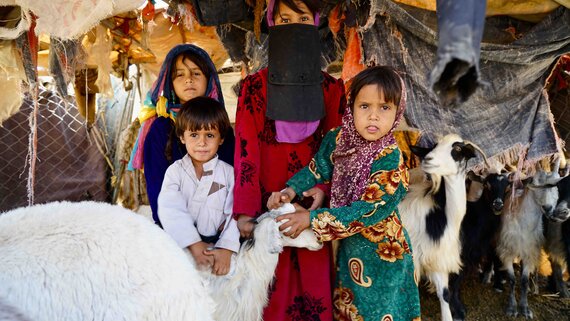
Marib, Yemen
Three displaced children in front of their tent with their family goats. They live in an IDP settlement recently built near Marib.
OCHA/Giles ClarkeWith the grave humanitarian situation combined with economic collapse, sustained scale-up of humanitarian assistance is needed now and in 2022. Aid agencies’ famine-prevention efforts were succesfull, but lack of sustained support now and in 2022 could aggravate the situation further by losing the progress achieved. Sectors such as health, water, sanitation and hygiene (WASH), education, protection and other critical sectors remain severely underfunded. Fuel shortages could impact the provision of water and the capacity to run hospitals. Proportionate to the needs, funds for food insecurity remain critical in mitigating the effects of seven years of conflict, as the underlying drivers of hunger continue to deteriorate. In parallel, the international community must seize immediate opportunities to stem Yemen’s economic collapse. Robust economic support is feasible in Yemen and could quickly and substantially reduce the scale of humanitarian needs.
Response priorities in 2022
During 2022, more than 170 partners across Yemen plan to assist 16 million people. Until the end of August 2021, an average of 10.9 million people were reached with humanitarian assistance in Yemen per month. On a monthly average, 10.2 million most vulnerable food insecure people are receiving life-saving emergency food assistance. However, most of these beneficiaries have been receiving assistance every two months instead of monthly. Over 3.48 million people received WASH services; 530,000 people were supported by Health Cluster partners; 773,750 received nutrition services; more than 275,000 people were reached through different protection services and engagement, despite access challenges and capacity gaps in specialized services; almost 600,000 people were supported by humanitarian actors in some 440 IDP sites through services and maintenance work; and 1.1 million people, including IDPs, returnees and vulnerable host-community members, received shelter and NFI support.
Yemen HRP
The humanitarian response in 2022 will continue to focus on preventing famine and disease outbreak; reducing mortality and morbidity; malnutrition; restoring livelihoods; improving the housing situation; enhancing access to basic and public services; and providing specialized protection services and assisting civilians in need.
With the protracted displacement, it is equally critical to analyse, strategize and support progress towards durable solutions to displacement, where feasible. Humanitarian partners will also escalate global advocacy for robust economic support to reduce humanitarian needs – including the risk of famine – more sustainably.
Further reading
Source: OCHA
Source: Humanitarian Insight
Source: Financial Tracking Service
References
- The 2022 number of people in need is a decrease of 40 per cent, as compared to the 4.1 million identified in 2021.
- The targets and costs presented in this document reflect preliminary estimates that may be further adjusted as the Iraq HCT reviews and vets the draft programmatic response and targeting for 2022, as the HRP is being finalized.
- The current analysis for the ERP (August 2021-July 2022), has been based largely on secondary data. Under the leadership of the HCT, OCHA is currently partnering with REACH to conduct a Multi-Sector Needs Assessment, with results expected by the end of 2021 to be used to update the ERP in early 2022.
- Estimate – the 2022 HNO process, including intersector PiN estimation, was ongoing at the time of publication
- Estimate – the 2022-2023 HRP process, including intersector target estimation, was ongoing at the time of publication.
- Estimate – the 2022-2023 HRP process, including cost estimation, was ongoing at the time of publication. The figure presents estimated costs for the first year (2022) of a multi-year Syria HRP for 2022 and 2023.
- Figures for people in need, people targeted and requirements are pending the finalization of the 2022 HNO and HRP.

